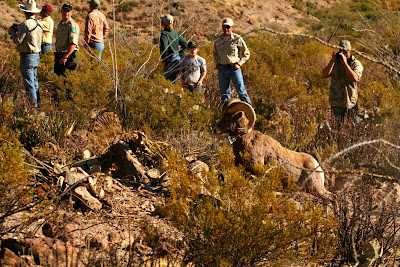 Solstice Moon and Sunrise, Elephant Mountain WMA, Texas.
Solstice Moon and Sunrise, Elephant Mountain WMA, Texas.Copyright (c) Dec 21, 2010 Wendee Holtcamp
I just got back from a short but amazing short trip to West Texas near the Mexico border to report on a desert bighorn sheep relocation project. I drove to Austin and then carpooled with some folks from Texas Parks & Wildlife Department, and the first and third evenings we stayed at the gorgeous Lajitas Resort in between Big Bend National Park and Big Bend Ranch State Park. The second evening we stayed in Alpine, Texas because there was a safety and sheep briefing at Sul Ross University. The second day we arrived at Elephant Mountain Wildlife Management Area at 6am and as soon as the sun came up got to work. A helicopter crew - they're freaking amazing - captured the sheep on the mountain using nets and then transported them down to the staging area below where we got to work on the animals.
Talk about alien abduction! You can imagine what the sheep is thinking - there is nothing in their evolution or natural history to comprehend flying through the air suspended by rope, then being placed in a stretcher, blood taken, poop taken and a collar placed around their neck. BUT it's truly for a good cause. People helped cause the extirpation of desert bighorn sheep from Texas by the 1950s but now have re-established them over the past couple of decades to a population of around 1100 in Texas. This particular project was about moving them to a mountain range they formerly inhabited but have not re-established themselves on, in Big Bend Ranch State Park. We had a phenomenally successful two days, reintroducing 46 bighorn sheep - 12 rams and the rest ewes. I was only there for the first day. Here are some photos! Next adventure- Christmas and Lake Texoma.
 On the drive to Lajitas the first day, I took this image on the roadside. I took all photos (all copyright) below except the helicopter one.
On the drive to Lajitas the first day, I took this image on the roadside. I took all photos (all copyright) below except the helicopter one. Tom Harvey, Texas Parks & Wildlife Department Media Communications Group Leader
Tom Harvey, Texas Parks & Wildlife Department Media Communications Group Leader We stayed at Lajitas Resort the first and third nights. It's really a gorgeous place. It's between Big Bend National Park & Big Bend Ranch State Park (which are next to one another).
We stayed at Lajitas Resort the first and third nights. It's really a gorgeous place. It's between Big Bend National Park & Big Bend Ranch State Park (which are next to one another). Quicksilver air pilots capture the bighorns using nets, and then carefully set them down in the staging area. They're amazing! Isn't this shot incredible?! This photo is Copyright (c) Texas Parks & Wildlife Dept. You can see their Flick photostream here: http://www.flickr.com/photos/texasparkswildlife
Quicksilver air pilots capture the bighorns using nets, and then carefully set them down in the staging area. They're amazing! Isn't this shot incredible?! This photo is Copyright (c) Texas Parks & Wildlife Dept. You can see their Flick photostream here: http://www.flickr.com/photos/texasparkswildlife After the helicopter captures the sheep on Elephant Mountain (Elephant Mountain Wildlife Management Area (WMA)), they gently lay them down at the staging area, where a crew carries them over to where we processed them as quickly as possible.
After the helicopter captures the sheep on Elephant Mountain (Elephant Mountain Wildlife Management Area (WMA)), they gently lay them down at the staging area, where a crew carries them over to where we processed them as quickly as possible. 'Processing' a desert bighorn ram before placing him in the carton/trailer for transport to Big Bend Ranch State Park. They're blindfolded because it helps calm them. Blood, fur and fecal samples are taken for DNA/genetic work and to check for parasites, and they're outfitted with a radio transmitter.
'Processing' a desert bighorn ram before placing him in the carton/trailer for transport to Big Bend Ranch State Park. They're blindfolded because it helps calm them. Blood, fur and fecal samples are taken for DNA/genetic work and to check for parasites, and they're outfitted with a radio transmitter. That's me in the background and to the right is Mike Janis who is a TPWD wildlife biologist I happened to have worked with almost 20 years ago at EG&G when we were seasonal field biologists on the Nevada Test Site. Small world!
That's me in the background and to the right is Mike Janis who is a TPWD wildlife biologist I happened to have worked with almost 20 years ago at EG&G when we were seasonal field biologists on the Nevada Test Site. Small world! A couple of the ewes in the trailer. I peered through the slats in the side and they kind of made a huffing sound at me, but that was it. They didn't mew or make any other noises.
A couple of the ewes in the trailer. I peered through the slats in the side and they kind of made a huffing sound at me, but that was it. They didn't mew or make any other noises. They look a bit scared, but I would be too. We did everything possible to minimize stress on the animals, including keeping them cool if their temperature started to rise, and doing the entire handling process in approximately 5 minutes.
They look a bit scared, but I would be too. We did everything possible to minimize stress on the animals, including keeping them cool if their temperature started to rise, and doing the entire handling process in approximately 5 minutes. The release site at Big Bend Ranch St Park is right on the Rio Grande River, so technically the sheep could just walk on over to Mexico... And in fact TPWD just signed a binational Memorandum of Understanding with CEMEX (a cement company that owns land on the border) and some other entities to manage the species cooperatively across the border. A couple of their biologists - Billy Pat and Bonnie McKinney - formerly worked with TPWD at the Black Gap Wildlife Management Area where one of our state's herds of desert bighorn sheep are.
The release site at Big Bend Ranch St Park is right on the Rio Grande River, so technically the sheep could just walk on over to Mexico... And in fact TPWD just signed a binational Memorandum of Understanding with CEMEX (a cement company that owns land on the border) and some other entities to manage the species cooperatively across the border. A couple of their biologists - Billy Pat and Bonnie McKinney - formerly worked with TPWD at the Black Gap Wildlife Management Area where one of our state's herds of desert bighorn sheep are. A shot of the insanely beautiful Panther Canyon area where we released the bighorns. They have to compete with exotic Aoudad (or Barbary) sheep, introduced from Saharan Africa. They're larger and can survive anywhere... they've had to try to control the Aoudad's population to ensure the bighorns will survive and thrive.
A shot of the insanely beautiful Panther Canyon area where we released the bighorns. They have to compete with exotic Aoudad (or Barbary) sheep, introduced from Saharan Africa. They're larger and can survive anywhere... they've had to try to control the Aoudad's population to ensure the bighorns will survive and thrive. Another shot of the area where the bighorns were released.
Another shot of the area where the bighorns were released. The biologists released the group of ewes first. This is one of the ewes jumping nimbly to her freedom in her new home. They all went straight up the mountain.
The biologists released the group of ewes first. This is one of the ewes jumping nimbly to her freedom in her new home. They all went straight up the mountain. Next the rams were released.
Next the rams were released. And there they go!
And there they go!






No comments:
Post a Comment